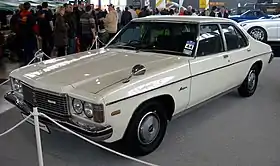Mazda Roadpacer AP
The Mazda Roadpacer AP (Anti-Pollution) is a full-size sedan that was sold by Mazda in Japan between 1975 and 1977, although the last car was not sold until 1979. It was based on the Australian Holden HJ and HX series Premier.[1] Premiers were shipped to Japan without engines or transmissions, and Mazda fitted a 1.3-liter 13B Wankel engine into the bay. The Roadpacer AP has the distinction of being the only General Motors product ever to be fitted for production with a rotary engine.
| Mazda Roadpacer AP | |
|---|---|
 | |
| Overview | |
| Manufacturer | Mazda |
| Production | 1975–1977 |
| Body and chassis | |
| Class | Full-size car |
| Body style | 4 door luxury sedan |
| Layout | Front-engine, rear-wheel drive |
| Platform | Holden HQ platform |
| Related | Holden HJ Premier |
| Powertrain | |
| Engine | 1.3 L 13B Wankel |
| Transmission | Jatco 3N71B three speed automatic transmission |
| Dimensions | |
| Wheelbase | 2,830 mm (111.4 in) |
| Length | 4,850 mm (190.9 in) |
| Width | 1,885 mm (74.2 in) |
| Height | 1,465 mm (57.7 in) |
| Curb weight | 1,575 kg (3,472.3 lb) |
The engine produced 130 hp (97 kW) but just 102 lb⋅ft (138 N⋅m) of torque, meaning the Roadpacer performed rather poorly as it weighed 1,575 kg (3,472 lb).[2] The Roadpacer was introduced to compete with large Japanese flagship sedans Toyota Century, Nissan President, Isuzu Statesman de Ville, and the Mitsubishi Debonair. The Roadpacer's platform was the shorter version of the one used by Isuzu for the Statesman de Ville. The Roadpacer was conceived just years before Mazda entered into an engineering partnership with Ford, which materialized at around the same time the Roadpacer went on sale.
The 13B produced less power than the Red series motors that powered the equivalent Holdens, and significantly less torque, meaning performance was restrained with a 166 km/h (103 mph) top speed, poor acceleration and terrible fuel consumption.[2] Contemporary reports suggest 9 mpg (26 L per 100 km).[2] The three-speed automatic transmission with a steering column shift lever was sourced from Jatco and was shared with the LA series Mazda Luce. The vehicle was not in compliance with Japanese regulations concerning engine displacement and exterior dimensions, and was classed in the mid-size car segment, while the engine displacement placed it in the lower annual road tax brackets. If the car was recognized as being for business use as an executive company car, the road tax bill was very minimal.

While the Holden HJ Premier itself was well equipped, Mazda decided to add more. Gadgets of note include a central locking system that activated when the car hit 10 km/h (6.2 mph), a chime system that activated at 90 km/h (56 mph), a dictation system and a stereo able to be controlled from both front and back seats. The interior was offered with a choice of velour upholstered bucket seats and a center console for the front passengers or a split front bench seat. The Roadpacer was built only for the Japanese market, and certain aspects concerning its lack of speed become evident once its realized that urban two-way streets are usually zoned at 40 km/h (25 mph) or less,[3] as mentioned in the article Speed limits in Japan.
The price was also considered high at ¥3.8 million yen (US$13,000) in 1975 ($70,700 in 2022 dollars [4]). This was about twice the price of a contemporary Mazda Cosmo or Mazda Luce and the installation of numerous luxury amenities would be introduced again in 1990 on the Eunos Cosmo. Originally intended as transport for high-ranking government officials, the car was sold in the wake of the first fuel crisis and was not a commercial success. Production ceased in 1977 with only 800 units sold. Most were sold to government departments and were later crushed, meaning Roadpacers are rare nowadays; their counterpart model, the Holden Premier is considered a classic car in Australia.
One can be found on display in the Transport World Motor Museum in Invercargill, New Zealand.
References
- Bedwell, Steve (2009). Holden vs Ford: the cars, the culture, the competition. Dulwich Hill, New South Wales: Rockpool. ISBN 978-1-921295-17-1.
- George, Patrick (2013-02-10). "The Mazda Roadpacer Was a Big Holden with a Rotary Engine for Some Reason". Jalopnik. Archived from the original on 2022-09-29.
- "Driving in Japan". Japan-Guide.com. Japan-Guide.com. Retrieved 22 February 2017.
- 1634–1699: McCusker, J. J. (1997). How Much Is That in Real Money? A Historical Price Index for Use as a Deflator of Money Values in the Economy of the United States: Addenda et Corrigenda (PDF). American Antiquarian Society. 1700–1799: McCusker, J. J. (1992). How Much Is That in Real Money? A Historical Price Index for Use as a Deflator of Money Values in the Economy of the United States (PDF). American Antiquarian Society. 1800–present: Federal Reserve Bank of Minneapolis. "Consumer Price Index (estimate) 1800–". Retrieved May 28, 2023.
External links
![]() Media related to Mazda Roadpacer at Wikimedia Commons
Media related to Mazda Roadpacer at Wikimedia Commons